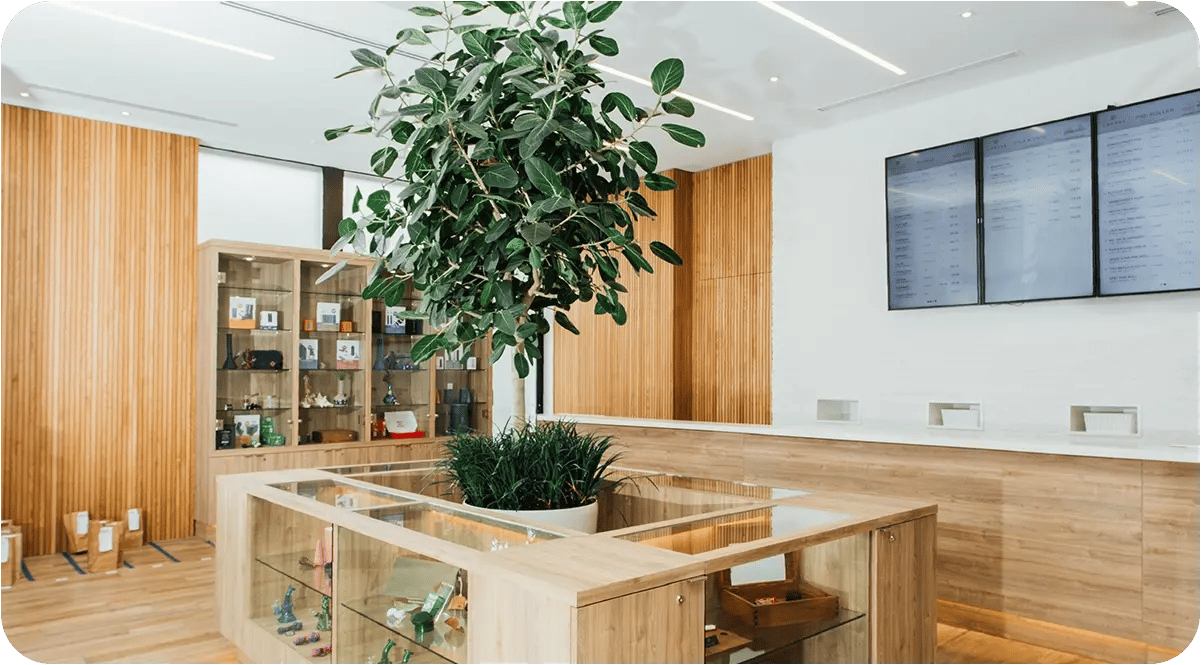
When it comes to the style of layout for your dispensary, you’ll need to consider your state, provincial, and local regulations as well as the type of experience you want to provide. Are you a medical dispensary? A recreational cannabis retailer? A hybrid store? The type of operation you’re running can help you determine the type of layout to choose.
Behind the Counter (bank model)
The bank model emphasizes the security and safety of products and has traditionally been the most common layout for medical marijuana dispensaries. As recreational cannabis has been legalized over time, many dispensary owners adopted the same model as it’s easy to manage with all the compliance regulations surrounding adult-use cannabis. But it doesn’t provide an immersive customer experience to consumers who want to see products before buying them.
- Inventory is stored in an area behind the counter that only staff has access to.
- There’s a waiting area for customers to get their IDs checked before entry.
- One budtender attends to one customer and builds a direct relationship.
While this model allows for a personalized customer experience, it can sometimes hinder the flow and turnaround time and result in inefficiencies.
Anywhere on the Floor (open retail model)
The open retail or mobile model is a customer-focused dispensary layout plan that many modern cannabis retailers have adopted. In this layout, products are displayed in open or glass cases for people to browse and pick up themselves if permitted. It can be challenging to manage inventory and security, and you’d need robust dispensary SOPs and inventory control. A mobile tablet such as one with Cova POS allows you to build a virtual cart anywhere on the floor and curates a positive customer experience.
- Customers don’t need to wait and can explore the dispensary floor.
- Cannabis products can be supplied from a central inventory area.
- Budtenders roam around with POS tablets and can attend to multiple customers.
The open retail model gives more flexibility to the customer and generally leads to a higher-than-average transaction amount, but it may require more staff to manage the flow.
Medical Inventory Control (pharmacy model)
The pharmacy model is not very common and is only used by medical dispensaries in states where regulations are stringent. In this layout, inventory is centrally located and securely accessible only by select employees. Generally, a patient or customer’s ID is verified in the check-in area, and then the budtender attends to them. However, the budtender only handles the transaction and provides a receipt from the dispensary POS, while staff managing inventory control hand out the product after final verification.
- Customers must wait in the check-in area before a budtender is available.
- Products are pre-packaged and verified by staff before handing them over.
- Budtender only handles POS transactions and not the product.
This model allows for tight cannabis inventory control and tracking, which eases auditing, cannabis compliance, and security concerns.
Self-Service (kiosk model)
This dispensary model consists of self-service kiosks where people can browse through products on a screen or tablet and build a cart on their own. This model does not require a lot of dispensary staff and may not necessarily provide a personalized customer experience. But if you have extensive information on the kiosk screens, this model works pretty well if your target market consists of cannabis connoisseurs or people who know what they want to buy. Make sure that you have a check-in area for ID verification.
- Customers can walk in anytime as long as there’s a kiosk available.
- Inventory can be easily managed as per any other model.
- Payment is processed automatically on the kiosk POS and staff hand over the order.
This is an extremely secure dispensary layout model from a compliance perspective as no products are displayed live. But you may have a floating budtender to help customers.




